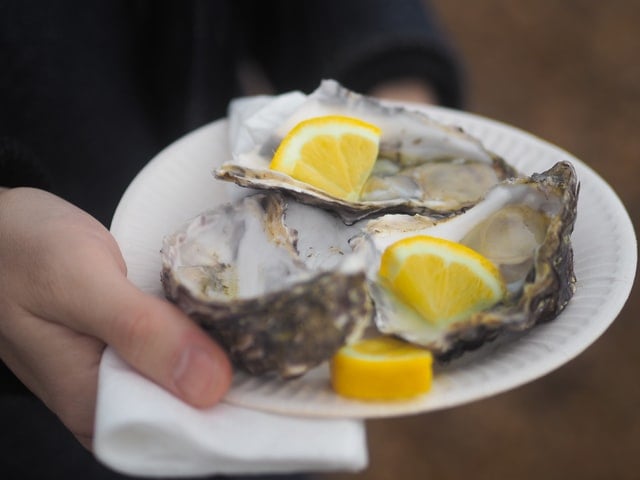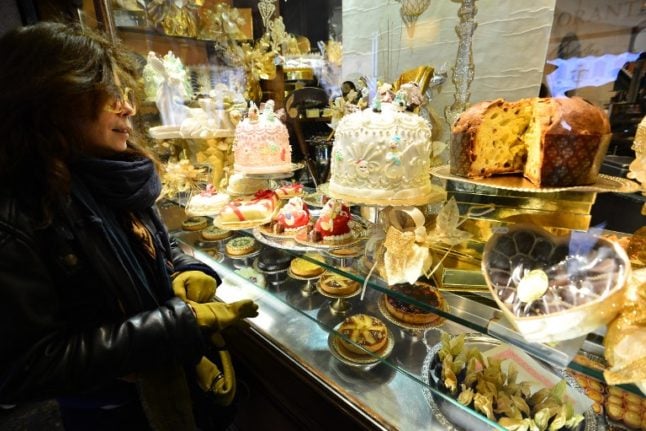Seafood
The evening meal on Christmas Eve (La Vigilia) is traditionally based around fish, as a meat-free day before the decadence of the 25th.
If you eat at an Italian home or restaurant on this date, you’re almost certain to be served a wide array of seafood in various forms.
READ ALSO: Ten words you need to know for an Italian Christmas
Some families will serve seven types of fish as the meal is known as the Festa dei sette pesci (Feast of the seven fishes) and seven is a symbolic number in Christianity. But don’t surprised if nine or even more different dishes are served.

Photo: Liza Pooor on Unsplash
Eel is one traditional component, with cod, octopus, king prawns, oysters and other types of shellfish all popular choices.
These may be served grilled or raw, depending on where you are, as every part of Italy has different regional favourite recipes and traditions.
Crostini
Rustic crostini generally make an appearance on the Christmas table as a starter, with a topping such as paté, prosciutto and figs, or tomato and mozzarella.
If you’re going to any Christmas parties, expect to see plates piled high with different varieties – they make the perfect bite-sized appetizer.
Pasta
In Italy, you simply can’t have Christmas (or any other day, come to think of it) without a pasta dish.
READ ALSO: Italy’s Christmas markets: Where and when to visit in 2023
The methods of cooking vary from region to region and household to household, but two typical staples of the Christmas dinner table are tortellini in brodo (broth) in the north, and lasagna or any other type of pasta al forno (baked pasta) in the south of the country.
Turkey
Yes, some families do eat turkey at Christmas in Italy, although it’s not usually the standard centrepiece and may feature alongside various other meats on an Italian Christmas table.
Turkey is however becoming more popular as an option on Christmas Day, likely due to American influence. Other Christmas classics include stuffed chicken or capon.

Photo: Claudio Schwarz on Unsplash
Veal or ox
Traditional recipes using veal or ox are common alternatives to a poultry-based second course. Again, each region has its own way of preparing the meat and the accompanying vegetables, but two typical recipes are ossobuco alla milanese, or boiled ox, a dish native to Piedmont and Puglia.
Panettone or pandoro
On to dessert! The festive feast is finished off with a slice of panettone, a traditional domed Christmas cake made from sweet brioche bread, usually studded with pieces of candied fruit.
When the Christmas period rolls around you’ll see boxes of panettone stacked from floor to waist-height in every supermarket you enter, and your local pasticceria will no doubt have more elaborate versions flavoured with anything from chocolate to pistachio cream.
READ ALSO: Panettone or pandoro: Which is the best Italian Christmas cake?
Somewhat similar to a panettone, the pandoro is denser, richer, taller, and with a slightly more delicate flavour and texture.
True to its name (pandoro = golden bread), the cake is yellow-golden in colour. It sits higher than an a panettone and is baked into a star shape, with the base wider than the top.

A pandoro is usually served plain with a dusting of icing sugar (often provided in a separate packet, to be added right before serving by shaking along with the cake in its cellophane wrapping to completely coat its exterior).
You’re likely to find the two cakes vying for prominence at any Italian Christmas dinner table. Some families will proudly declare a strong preference for panettone or pandoro, while others simply buy one of each to save argument.
Torrone
The name of this dessert means ‘big tower’ (though it actually comes from the verb for ‘to toast’) so you know you’re in for something spectacular. It’s made of honey and sugar and is basically a kind of nougat – the Toblerone chocolate bar was inspired by this sweet’s popularity.
The recipe varies depending on where you are in Italy. In the north you’ll often find varieties made with hazelnuts, while in the south almond-based recipes are more typical.
READ ALSO: Where to catch Italy’s most impressive Christmas displays in 2023
Biscotti, pastries and donuts
There are likely to be plenty of sweet treats at the end of the meal, enjoyed with coffee. In Naples, honey-covered dough balls (struffoli) are often on the menu; chestnut tortelli (crescent-shaped parcels stuffed with the sweet filling) are another classic, and biscotti get a seasonal twist with cinnamon or nutty flavourings.
Prosecco
Red or white wines are usually served to match each course, and after you’ve finished eating, it’s time to move onto the bubbles. Prosecco, or another variety of Italian sparkling wine, is one of the most popular ways to finish off the meal.
If you’d rather have your fizz as a pre-meal drink, rest assured that it’s equally popular at aperitivo hour.

Photo: Mel Maldonado-Turner on Unsplash
Bombardino
Literally translating as ‘the bomb’, this tasty drink is basically Italian eggnog. It’s made up of brandy, zabaione (egg cream), whipped cream and cinnamon, hails originally from the Lombardy region and is often the apres-ski drink of choice at Italy’s ski resorts. But it’s also perfect for a cosy Christmas afternoon by the fire.
If you don’t have those ingredients at your disposal, a caffè corretto is a simpler option: an espresso with a drop of something strong, usually grappa, but brandy or sambuca are also popular additions.
Buon appetito!




 Please whitelist us to continue reading.
Please whitelist us to continue reading.